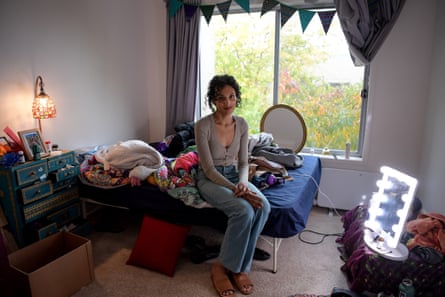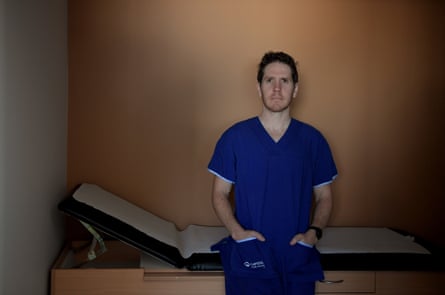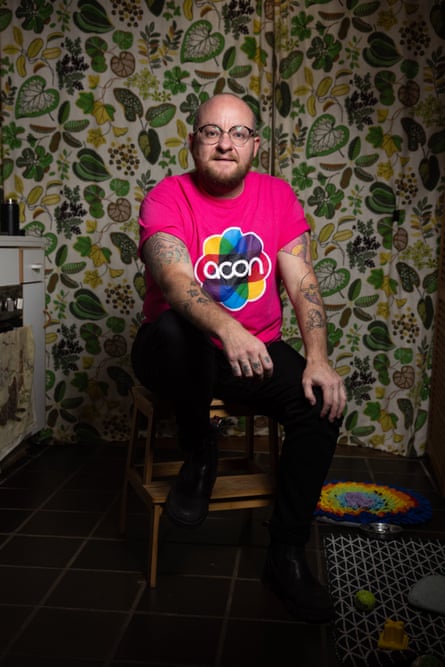Two years ago, Kavitha Sivasamy, an articulate, elegant Canberra lawyer, began to face her fears about undergoing gender-affirming surgery. “It’s really scary to go through something so invasive,” she says.
Gender dysphoria had been causing “a lot of distress” in Sivasamy’s day-to-day life. “It can prevent you getting out the door, having and keeping a job, sustaining healthy relationships,” the 27-year-old says. “The list goes on.”
She embarked on a course of hormone replacement therapy, and she liked the physical changes she was seeing, but this meant her “genital dysphoria became more salient”. There was a disconnect between her aspirations for her body and how it looked in the moment.

But Australia is facing a shortfall in surgeons who perform lower body gender-affirming procedures. So, in a route that experts say more Australian trans people are taking, Sivasamy will travel to Thailand for surgery under a medical tourism company’s “one-month care package”. Like some others, she will access her superannuation to pay for the $30,000 procedure.
Sivasamy made her choice after spending many months researching the experiences that others had of surgery. She decided a peritoneal pull-through, adapted from a procedure pioneered in India on cisgender women born without a vagina, was the type of vaginoplasty with the most positive benefits for her.
The standard vaginoplasty has long been a penile inversion, where penis skin is refashioned as the lining of a new vagina. The newer method, using tissue from the patient’s peritoneum membrane in the abdominal cavity, is said to offer greater vaginal depth. However, there is a lack of data on post-surgical quality of life for trans patients.
Sivasamy had been referred to Dr Kieran Hart, a Canberra-based urologist who performs this procedure, but she soon learned that she might have to wait a year and a half to have the surgery here. The idea of delay only compounded her distress.
“Having overcome family, workplace and social barriers, why put the critical years of your 20s and 30s on hold because of the wait in Australia?” she says. She will fly to Bangkok in May.
One surgeon, 120 patients waiting
Only a handful of Australian surgeons offer lower body gender-affirming surgery such as vaginoplasty for trans women, with even fewer offering phalloplasty (penis creation) for trans men. No surgical college offers formal training guidelines, forcing doctors to learn overseas.
Trans health advocates say Medicare is “woeful” and failing to offer any item numbers for medical procedures specifically for gender incongruence, causing confusion about what, if any, aspects of gender-affirming surgeries are eligible for government subsidy.
Private health insurance coverage for gender-affirming surgery is often prohibitively expensive. Even a fully insured person is left out of pocket by up to $20,000 for a vaginoplasty performed in Australia.
An evidence brief prepared in 2021 by the New South Wales community health organisation ACON found that most states and territories have elective surgery policies that “explicitly restrict access to surgical interventions for trans people through public health systems”, forcing trans people into local private care or surgery abroad.
Dr Clara Tuck Meng Soo, a GP and the president of the Australian Professional Association for Trans Health (Auspath), says a lot of her patients “now don’t even bother to go on the waitlist; they just choose to go to Thailand”.
“We have very high rates of mental health harm, and this care and affirmation and support is critical to reducing that harm,” says Soo, who is a trans woman. “But shouldn’t we also be able to access care that we feel we need as a human right?”
Hart says he has 120 trans patients booked and waiting for gender-affirming surgeries, with another 70 scheduled for consultations, and estimates “probably 10 times more” trans people are waiting for surgery across Australia.

Hart has closed his bookings and will reopen them in the second half of this year for consultations to be held in 2024 – with potential surgeries months later.
However, he says he will expedite a surgery if a psychiatrist or family is worried a patient might not survive an 18-month wait. Transgender people have vastly higher self-harm rates than the general population – a 2021 study found 43% of trans Australians surveyed had attempted suicide.
Like others performing lower body gender-affirming surgeries in Australia, Hart came by training in the area by chance: he was taught by the late Phil Thomas at London’s Charing Cross hospital. Hart had only travelled there to train in prostate and bladder cancer surgery.
Based on follow-ups of how patients fared physically and mentally after the procedures, Hart is “convinced” that surgery “must drop the suicide rate”.
Over the past year, Hart’s workload increased in part because of the waves of referrals he was getting from two surgeons winding down their vaginoplasty procedures, including Melbourne plastic surgeon Andrew Ives. Until recently Ives a high profile in the field, but, as his office confirmed in an email, he ceased performing vaginoplasty and labiaplasty procedures at the end of 2022.
In February, Melbourne’s Monash Gender Clinic told patients that it was only then booking appointments for patients referred in August 2021, and that Melbourne plastic surgeon Cheng Lo, trained in vaginoplasty and labiaplasty by Ives, has “very long wait lists”. Cheng did not respond to interview requests.
Hart says: “Andy Ives and I were looking at doing a formalised training program [for gender-affirming surgery], and as he stepped back I’ve looked at doing it myself, but it’s a daunting task. The [Royal Australasian] College of Surgeons has been a bit slow on the uptake for it, like every facet of the transgender sphere.”
In May, the college will hold a scientific congress titled Equity in Surgery in Adelaide, including for the first time talks on transgender healthcare. The college’s president, Sally Langley, admits in the program that the college’s surgeons “have not fully represented the gender … composition of our community”, but declined an interview request.
The many kinds of risk
Sivasamy acknowledges there are “risks” in having surgery in Thailand, but says the country “pioneered a lot of these procedures”.
Travelling abroad for these surgeries, even to a country that has pioneered them, comes with warnings of caution. Soo mentions reports of trans women suffering vagina narrowing or urethra complications after surgery, both in Australia and overseas. The question is: once the patient is back in Australia, who corrects the error?
Hart says surgeons are reluctant to fix another surgeon’s mistakes: “It’s impractical coming from Perth to Canberra to have it fixed up, but it’s far more practical than getting to Bangkok. As a developed nation there’s no reason people should be going overseas.”
Soo says there is also a shortfall of GPs, psychologists and other practitioners in trans health, but evidence “shows if you provide gender-affirming care, be it hormone treatment, surgery and/or social affirmation, [trans] people have very good mental health virtually indistinguishable from cisgender peers”.
Associate Prof Nicola Dean, the president of the Australian Society of Plastic Surgeons, says the federal government must create a dedicated suite of Medicare rebate item numbers for procedures for people with gender incongruence. This would encourage more surgeons into the field, Dean says, giving the surgeries a “stamp of legitimacy”.
For instance, the Medicare item number for a mastectomy was created on the assumption the procedure would be for a cisgender woman with breast cancer. “So using it for a trans man having surgery [to affirm his identity] leaves the doctor feeling vulnerable about whether they’re allowed to use those item numbers,” Dean says.
“It leaves the patient vulnerable because they’re often not sure of the financial implications.”
Associate Prof Peter Haertsch, a Sydney-based plastic surgeon, says he continues to perform about six vaginoplasty procedures a year. At his peak he was performing 30 gender-affirming procedures a year in Australia, beginning in the late 1980s after training in London.
Heartsch says some Australian surgeons have recently exited the field, but he doesn’t know why. “I have tried and am still trying to get some form of help in the way of government funding,” he says.
Another Sydney plastic surgeon, Dr David Caminer, says he performed his first vaginoplasty on a trans person in 2015, after which he toured the US and Europe to watch surgical units perform gender-affirming surgeries.
Up to the end of 2022 he had performed only a few vaginoplasties on trans patients, mainly with the penile inversion technique. But Caminer says so far in 2023 he has performed seven vaginoplasties due to the growing demand. “It was really since Andy Ives stopped doing it that I’ve been inundated with requests,” he says.
The Brisbane-based Dr Hans Goossen, who did not respond to interview requests, performs nearly all the phalloplasty procedures on trans men in Australia, according to the various trans health advocates Guardian Australia spoke to. Another surgeon, the Melbourne-based Dr Gideon Blecher, “has trained in phalloplasty and he is still trying to establish the program in Melbourne”, a spokesperson for Blecher said.
Fiona Bisshop, a Brisbane-based GP and former president of Auspath, says phalloplasty is particularly difficult for trans men to access in Australia, costing more than twice as much as a vaginoplasty. Bishop says almost all phalloplasty procedures have some complication, but three of her trans male patients who went overseas had particularly “terrible outcomes”.
“You can have some very bad experiences over in Thailand,” she says. “There are communication difficulties: the surgeons and hospital staff don’t speak very much English.”

Bisshop says many of her trans patients have “given up on gender-affirmation surgeries, because it is completely out of financial reach”, and she calls the “lack of respectability” afforded to gender-affirming surgery a “vicious circle”, because it is not offered in Australian teaching hospitals where physicians would normally train.
Gender-affirming care
Sydney-based Teddy Cook, ACON’s director of community health, says gender-affirming care means many types of “health interventions of critical need”, and such needs must be “depathologised” and trans people given autonomy.
The lack of comprehensive gender-affirming healthcare in Australia may be because this care is misunderstood as simply cosmetic or solely related to genital surgery, and because trans people are “seen through a lens of being mentally ill, as opposed to just being a natural part of human diversity”, Cook says.
Cook, who is a trans man, says not all trans people seek surgical intervention: “It’s up to the individual what sort of steps they take medically, but cruel legal gender recognition laws in NSW and other states still force surgical sterilisation to update a birth certificate.”
Cook says no reliable figures exist on how many trans people there are in Australia to better plan health services. When unveiling a 10-year national action plan for LGBTQ+ health in March, the assistant health minister, Ged Kearney, said attorney general Mark Dreyfus “might have things to say” about counting LGBTQ+ people in the census, but no announcement has been forthcoming.
As Sivasamy readies for her flight to Thailand, she knows she is one of the lucky ones, not least because she has enough money at a young age to finance the trip.
“The majority of people my age don’t have the superannuation funds to get this done,” she says.
She then opens her palms and waves her hands away, as if to banish doubts about a lack of contingency plan after the procedure. “Definitely, if there’s a readmission surgery necessary, I don’t have the money for that, you know?”
She laughs. “I have no idea what would happen. We’ll just have to cross that route if we come to it.”


